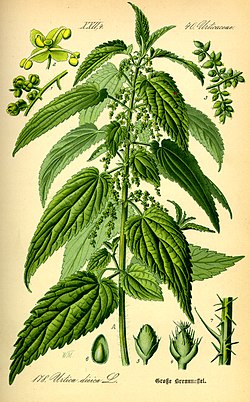European
An old Scots rhyme about the nettle: [16]
- Gin ye be for lang kail coo the nettle, stoo the nettle
- Gin ye be for lang kail coo the nettle early
- Coo it laich, coo it sune, coo it in the month o' June
- Stoo it ere it's in the bloom, coo the nettle early
- Coo it by the auld wa's, coo it where the sun ne'er fa's
- Stoo it when the day daws, coo the nettle early.
Coo, cow, and stoo are all Scottish for cut back or crop (although, curiously, another meaning of "stoo" is to throb or ache), while "laich" means short or low to the ground. [17] Given the repetition of "early," presumably this is advice to harvest nettles first thing in the morning and to cut them back hard (which seems to contradict the advice of the Royal Horticultural Society). Alternatively, it may be recommending harvesting early in the year before the plants grow tall, as they become tough and stringy later. [18]
The English figure of speech "grasp the nettle", meaning to nerve oneself to tackle a difficult task, stems from a belief that nettles actually sting less if gripped tightly. This belief gave rise to a well-known poem by Aaron Hill:
- Tender-handed, stroke a nettle,
- And it stings you for your pains.
- Grasp it like a man of mettle,
- And it soft as silk remains.
- 'Tis the same, with common natures,
- Use ’em kindly, they rebel:
- But, be rough as Nutmeg-graters,
- And the rogues obey you well. [19]
In Hans Christian Andersen's fairy-tale "The Wild Swans," the princess had to weave coats of nettles to break the spell on her brothers.
In the Brothers Grimm's fairy-tale "Maid Maleen", the princess and her maid must subsist on raw nettles while fleeing their war-ravaged kingdom. While standing in for the false bride during the wedding procession, she speaks to a nettle plant (which later proves her identity):
- Oh, nettle-plant,
- Little nettle-plant,
- What dost thou here alone?
- I have known the time
- When I ate thee unboiled,
- When I ate thee unroasted.





